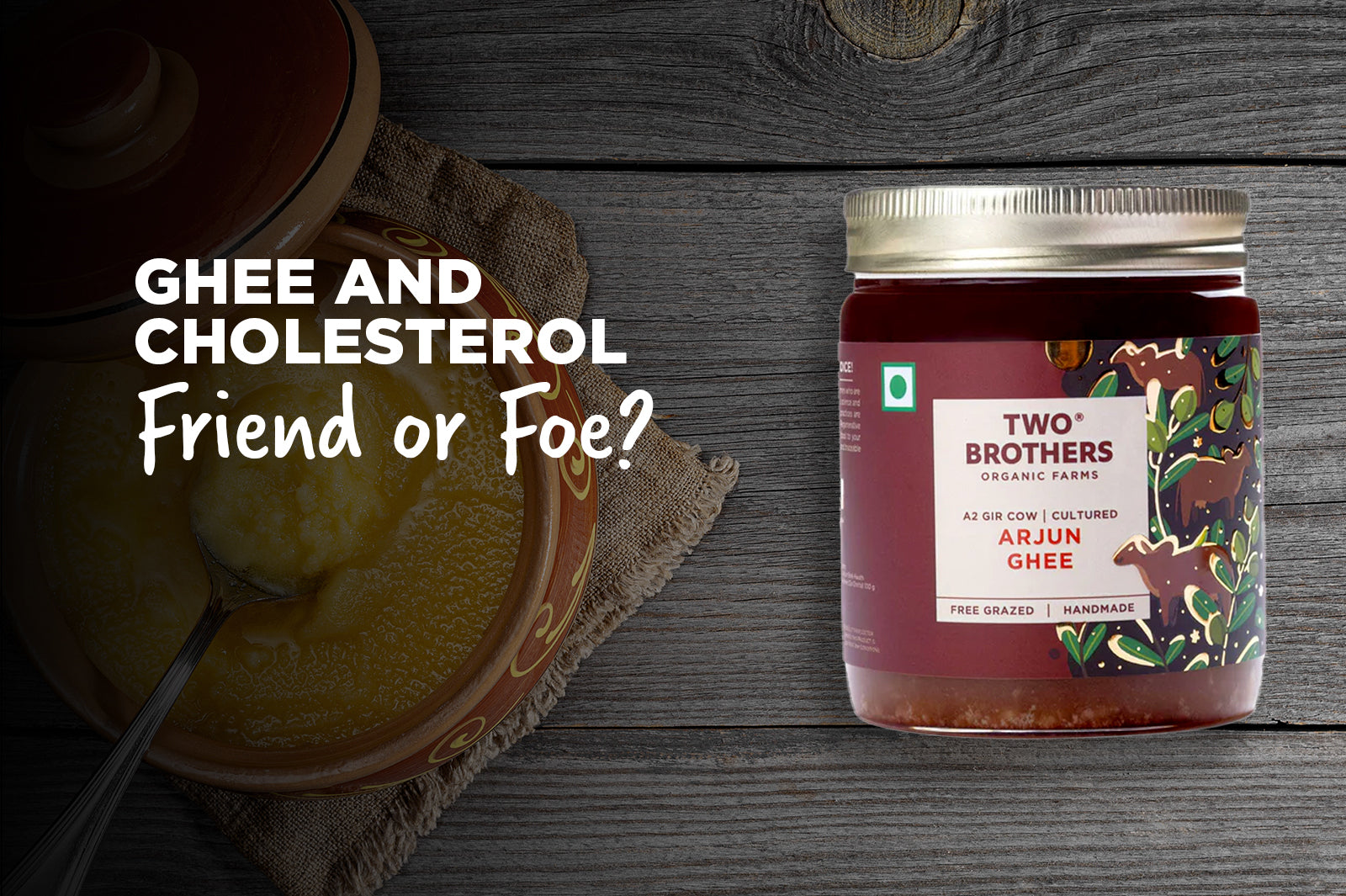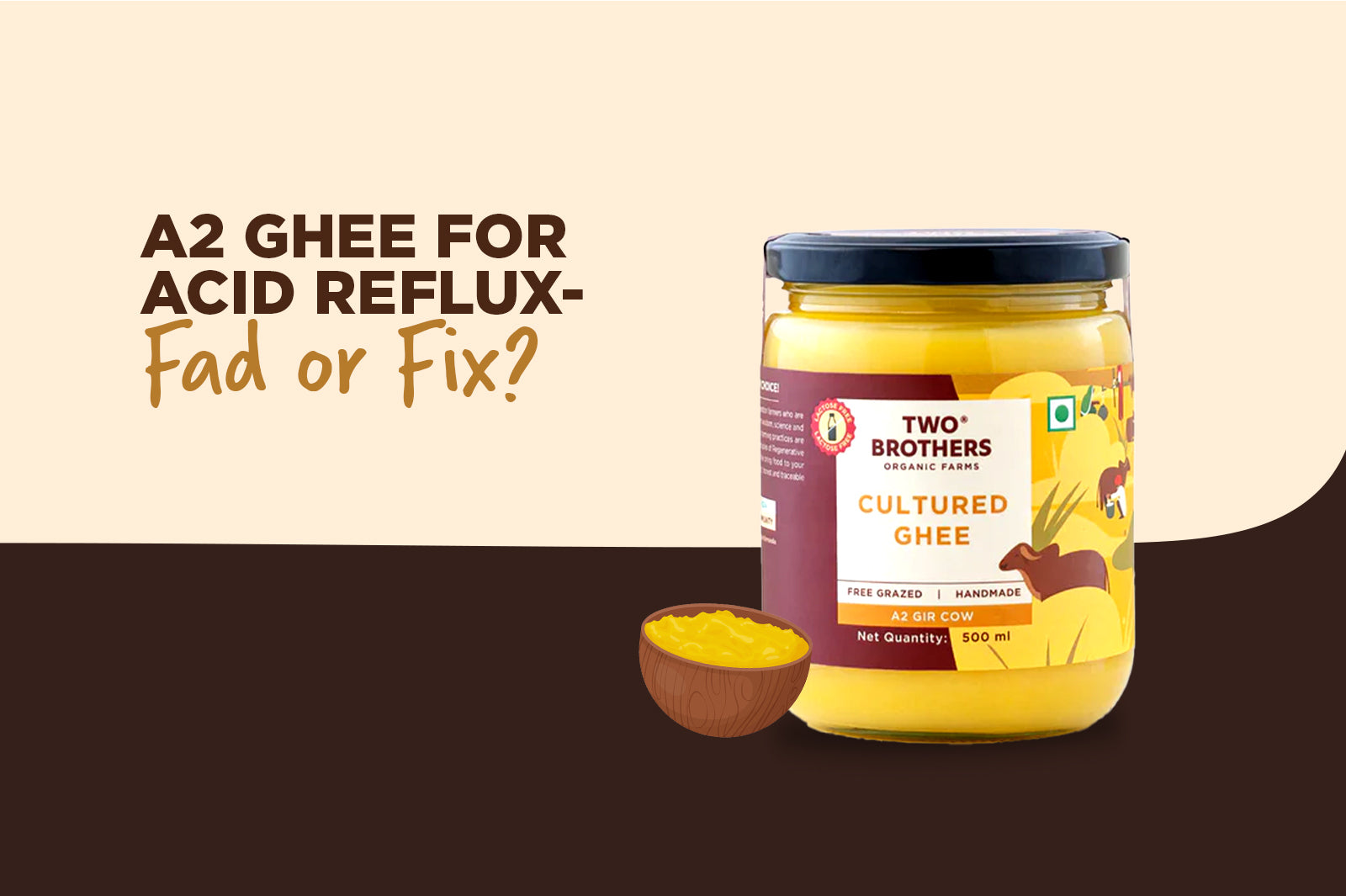Introduction
Ghee and clarified butter often appear interchangeable in recipes and grocery store shelves. But are they actually the same? You might notice both are golden and have a buttery aroma—yet, in traditional kitchens and modern nutrition, desi ghee benefits go beyond mere clarified butter. Meanwhile, ghee nutrition facts reveal surprising differences that affect flavor, aroma, smoke point, and even health impacts.
In this deep dive, we’ll explore what sets desi ghee apart from clarified butter. We'll unpack their production processes, taste profiles, and health credentials. We'll also share tips on when you can use them interchangeably and guide you on how to buy desi ghee online. If you're interested in wholesome cooking fats that nourish your body and soul, this guide will help you choose wisely.
Throughout, we will highlight selections from Two Brothers Organic Farms to help you find authentic, high-quality products you can trust.
What Is Clarified Butter?
Clarified butter, a staple in French cooking, is made by gently melting unsalted butter and removing milk solids and water. Here's a glimpse into the process:
When butter is heated, it separates into three layers:
-
Top layer: foam (mostly water and whey proteins)
-
Middle layer: golden liquid fat (pure butterfat)
-
Bottom layer: milk solids
To create clarified butter, the top foam is skimmed off, and the golden liquid is poured off and stored—leaving behind the solids. The result is a purer form of fat with a higher smoke point, making it ideal for sautéing, frying, and medium-heat cooking.
Clarified butter has a milder flavor and lacks the caramel-like aroma of ghee. It does offer a clean fat source with fewer impurities than regular butter, but lacks some of the depth and complexity of desi ghee.
What Is Desi Ghee?
Desi ghee, a traditional dairy fat from South Asia, undergoes a more intricate process compared to clarified butter. Made from cow or buffalo milk, the process starts traditionally with cream or curd, which is cultured, churned into butter, and then heated to remove moisture and separate the fat.
Unlike clarified butter, making desi ghee involves cooking the milk solids until they caramelize and develop a rich, nutty aroma. This final cooking step not only separates impurities but also infuses the fat with flavourful compounds and enhances nutrient stability.
Particularly when made from lie-desi cows, desi ghee is believed to hold spiritual and nutritional significance. The aroma is deeper, the taste richer, and the shelf stability is even greater due to the longer cooking and clarified process.
Key Differences: Desi Ghee vs Clarified Butter
1. Production Technique & Aroma
-
Clarified Butter: Made from unsalted butter by removing foam and solids. Heat is moderate, and solids aren’t cooked to caramel. Aroma and taste remain mild.
-
Desi Ghee: Produced by simmering cultured butter for an extended time. This caramelizes milk solids and releases flavorful compounds. The result? A nutty, golden liquid with a rich aroma—far more complex and distinctive than clarified butter.
2. Smoke Point & Heat Stability
Both clarified butter and desi ghee have high smoke points (~250 °C), making them excellent for most cooking needs. However, desi ghee typically exhibits greater stability due to thorough heating, making it forgiving across a range of cooking techniques—from searing to baking.
3. Flavor & Culinary Use
-
Clarified Butter: Neutral flavor, suited for Western-style cooking or where minimal fat flavor is desired.
-
Desi Ghee: Strong, nutty undertones enrich Indian dishes, enhance dals, elevate breads like roti or parathas, and even deepen the flavor of desserts like halwa or kheer.
4. Nutritional Profile & Health Impact
Here’s a quick comparison based on key ghee nutrition facts:
|
Component |
Clarified Butter |
Desi Ghee |
|
Fat content |
High (~99.9%) |
High, with beneficial fatty acids |
|
Vitamins A, D, E, K |
Low to moderate |
Rich due to caramelization process |
|
Conjugated Linoleic Acid (CLA) |
Lower |
Often higher, especially from pasture-raised cows |
|
Short-chain fatty acids |
Minimal |
Present, supporting gut health |
|
Aroma and flavor enhancers |
None |
Present |
Desi ghee is traditionally prized not just for its taste, but for its nourishing potential, supporting digestion, immunity, cognition, and more.
When Can You Use Them Interchangeably?
In many recipes, clarified butter and desi ghee can substitute each other without dramatically altering the outcome. Here are common scenarios:
High-Heat Cooking & Searing
Since both withstand high heat, they’re great in place of vegetable oil for sautéing, stir-fries, or searing meats. Desi ghee adds extra flavor; clarified butter remains more neutral.
Sauces & Basting
Clarified butter is standard in dishes like hollandaise or béarnaise. Desi ghee can be used if you don’t mind adding a richer, nuttier flavor.
Soups & Baking
In soups or bread recipes, the rich aroma of desi ghee enhances taste, while clarified butter offers a subtle touch. Use clarified butter for neutral baking; for richer, latte-style bakes, desi ghee works beautifully.
Spice Tempering
In Indian cuisine, tempering (tadka) is essential—and desi ghee enhances the final flavor far more than clarified butter. The nutty notes elevate spices like mustard seeds, cumin, and curry leaves.
Which Should You Choose?
When to Choose Clarified Butter
-
You need a neutral flavor for sauces, baking, or Western cooking.
-
You prefer a simple, minimal-fat base.
-
You don’t want strong aromatic notes.
When to Choose Desi Ghee
-
You’re cooking Indian cuisine or dishes that benefit from nutty richness.
-
You want desi ghee benefits like vitamins A/D/E/K, immunity, and deeper aroma.
-
You need a high-heat stable fat with a richer flavor and nutritional depth.

Where to Buy Desi Ghee Online
The benefits of desi ghee are best experienced when sourced from traditional, trusted producers. Two Brothers Organic Farms’ collection of desi ghee is a perfect choice—crafted using age-old Bilona-style methods, free from artificial additives, and derived from pasture-raised cows.
Explore their collection:
-
Bilona-pressed A2 Desi Cow Ghee – made with native cows, available in small glass jars.
-
Cow–Buffalo blend ghee – for robust flavour and slow digestion.
-
Organic Seed Ghee – with natural flavour twists (e.g., basil).
FAQs
Q. Is desi ghee healthier than clarified butter?
Not strictly “healthier,” but desi ghee offers richer ghee nutrition facts—including fat-soluble vitamins and antioxidants—due to its traditional preparation. It also has a deeper flavor profile.
Q. Can vegetarians use ghee?
Yes, desi ghee is vegetarian-friendly. In traditional Ayurveda, ghee is often considered sattvic (pure, beneficial) and used in cooking and rituals.
Q. Is clarified butter vegan?
No—clarified butter and desi ghee are both from milk and not vegan. For plant-based alternatives, consider oils like avocado, coconut, or olive.
Q. What is A2 ghee?
A2 ghee is desi ghee made from A2 beta-casein cow's milk (often from indigenous native cows). Many believe its proteins are easier to digest and more beneficial.
Q. How should I store ghee?
Due to its low moisture and high heat stability, desi ghee (and clarified butter) can be stored at room temperature for months. Keep it in a dry, airtight container away from heat.
Conclusion
While clarified butter and desi ghee share a similar golden hue and high heat stability, they diverge in production technique, aroma, flavor, and nutritional richness. Clarified butter is straightforward and subtly flavored, perfect for Western cooking needs. Desi ghee, on the other hand, is steeped in tradition, offering rich, nutty notes and nourishing compounds that enhance taste and well-being.
Ultimately, the choice depends on your culinary goals and wellness preferences. If you want heritage flavor, vitamins, and deeper aroma, desi ghee is the winner. If you prefer neutrality and simplicity, clarified butter may better suit your needs.
If you're ready to enhance your pantry with authentic ghee that delivers on tradition and wellness, consider exploring Two Brothers Organic Farms’ desi ghee collection:
Buy desi ghee online here













